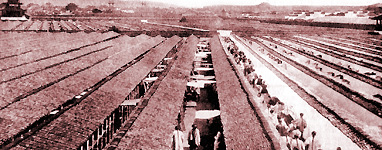of the Yangzi River Delta

| Course Syllabus & Readings |
The Yangzi river delta is home both to contemporary Shanghai and classic centers of late imperial Chinese culture like Nanjing, Suzhou and Hangzhou, immortalized in the popular Chinese saying “Above there is Heaven, below Suzhou and Hangzhou.” This course explores the region’s vital cultural, political, economic and literature role in the creation of modern China from the late imperial period to the present. Taught on-site in Nanjing, Suzhou, Shanghai and Hangzhou, the course provides students a direct experience of contemporary China’s connections to its past. This course will also provide students an opportunity to improve their Chinese language. 2 units- Williams, Jiang. |
| Course Texts |
The following books will be available for purchase at the CC bookstore beginning in block 7. All are currently marked down at Amazon.com as well. All other readings will be provided and/or posted at a later date.
|
| April |
19 (Mon) Orientation at John Hopkins University-Nanjing University Center for Chinese and American Studies. Class will meet with Hopkins Center staff for an introduction to the Center and its environs. 20 (Tue) : Confucianism & Chinese Culture 21 (Wed) : Nanjing and the Founding of the Ming 22 (Thu) : The Work of Feng Menglong 冯梦龙 (1574-1646) 23 (Fri): Jiangnan Examination Life 26 (Mon): Jiangnan during the Manchu Conquest 27 (Tue): The Heavenly Capital 28 (Wed): Sun Yat-sen 孙中山 (1866-1925) in Nanjing 29 (Thu) : Qiu Jin 秋瑾 (1875-1907) 30 (Fri) Day Trip: Purple Mountain 紫金山. Day trip to Purple Mountain to see the Ming Emperor Hongwu's tomb 明孝陵, Sun Yat-sen's Mausoleum 中山陵 and Linggu Temple 灵谷寺. |
| May |
3 (Mon) : Republican Era Literature 4 (Tue): Lu Xun 鲁迅 (1881-1936) 5 (Wed) : Ding Ling 丁玲 (1904-1986) 6 (Thu) : The Nanjing Decade 7 (Fri) : The Nanjing Massacre 10 (Mon) Morning: Class; conclude Nanjing segment of the course. 11 (Tue) TRIP TO HUANGSHAN 黄山: Class tours historic villas and other sites in She County 歙县, south of Mt. Huang, then Class spends the night at the base of Mt. Huang mountain. 12 (Wed) Huangshan: Class spends night on Mt. Huang. 13 (Wed)TRIP TO SHAOXING 绍兴: Class travels to Shaoxing, Zhejiang, hometown of 20th century literary giant Lu Xun. In the evening, Class travels on to nearby HANGZHOU 杭州. 14 (Fri)HANGZHOU: Class tours West Lake 西湖 and other important historical sites in Hangzhou. 15 (Sat) Afternoon: Class travels from Hangzhou to Shanghai 上海. 16 (Sun): Off. 17 (Mon) : Going to Shanghai 18 (Tue) : Republican Shanghai. 19 (Wed): Conditions of Modern Culture in Republican Shanghai. 20 (Thu): Expressions of Modern Culture in Republican Shanghai 21 (Fri) Field Trip: Shanghai Expo 2010 上海世界博览会 22 (Sat) Evening: Shanghai Acrobats 23 (Sun) : Off. 24 (Mon): Eileen Chang (Zhang Ailing 张爱玲, 1920-1995) & Wartime Shanghai 25 (Tue) : Revolutionary Shanghai 26 (Wed): Bolshevik Salute 27 (Thu): Gender & Revolution 28 (Fri): Traditional Aesthetics: The Gardens of Suzhou 29 (Sat): Field Trip to Suzhou 苏州 30 (Sun): Return to Shanghai from Suzhou. 31 (Mon): Contemporary Shanghai Youth Culture |
| June |
1 (Tue) Morning: Class; conclude Shanghai segment of course 2 (Wed) TRIP TO BEIJING 北京: Class travels overnight by train to Beijing. 3 (Thu) Morning: Class arrives in Beijing. Afternoon: Field trip to the Forbidden City 紫禁城 and Tiananmen Square 天安门广场. 4 (Fri) Day Trip: Great Wall of China 中国长城 at Mutianyu 慕田峪. 5 (Sat) Morning: Field trip to Temple of Heaven 天坛 and Yonghe Palace 雍和宫. Afternoon: Field trip to Olympic green. 6 (Sun) Free Time / Optional hutong 胡同 walking tour. 7 (Mon) Class ends in Beijing: Students return to U.S. or travel independently to other destinations. |